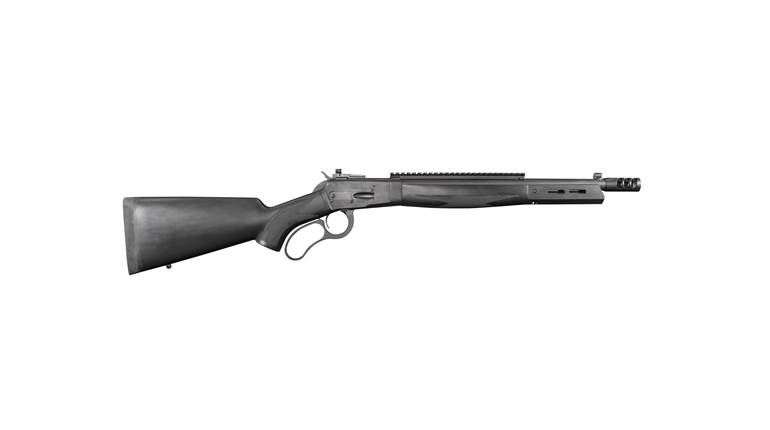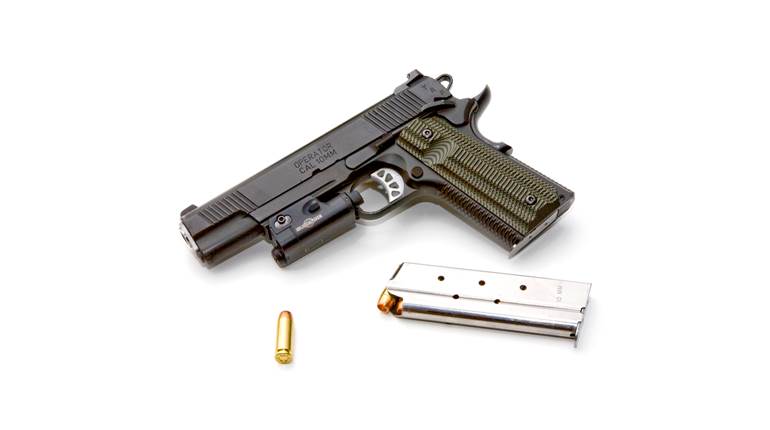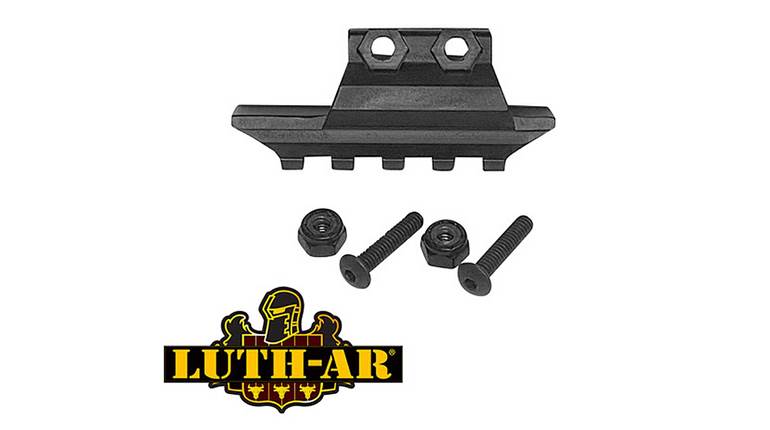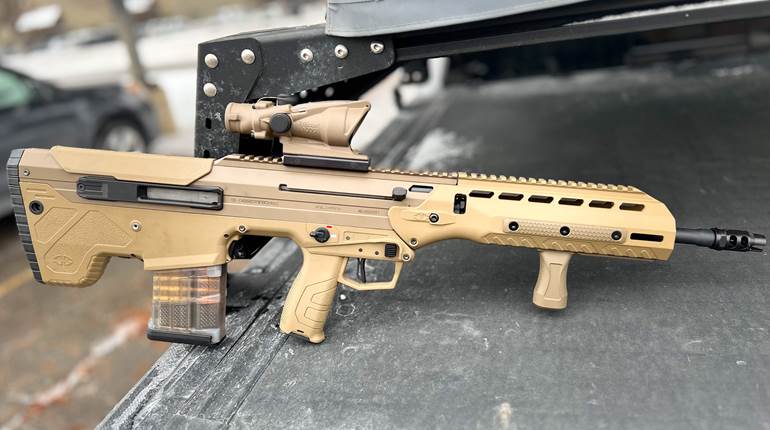
When I was a boy and finally persuaded my mother that I was trustworthy enough to have a BB gun—which took a lobbying effort akin to getting the U.S. Constitution amended, but that’s another story—I shot the hell out of it. At first I imitated my heroes from television. I found out quickly that I did not possess the natural ability to hit any target while standing or riding my bike (imitating being on horseback).
I needed some help. So I went to the library and checked out a book on shooting—something likely impossible to do today. The book was pretty good; in fact, a few years later I bought a copy of it, The Complete Book of Shooting, by Jack O’Connor, Alex Kerr and Jeff Cooper. I still have it. In the book, O’Connor spent quite a bit of time describing methods that help a shooter steady his rifle for an accurate shot.
O’Connor said that holding a rifle steady was nearly impossible since we humans are nothing but a mass of jittery nerves and quivering muscles supported by a bunch of bones with flip-flopping joints. He was old-school; his advice centered on a rifle sling set up for shooting—still a very good option—or resting the rifle over a rolled-up coat or garment. There was some mention of prone, sitting and kneeling positions, as well as a passing sentence or two of tripods made from bamboo, held together with a piece of truck tire inner tube often used by African professional hunters.
I poured over the advice intently and attempted to implement as much of it as a 10-year-old boy could. Soon I found that sitting on the back steps of the house and using my legs—not the knees—to support my shooting arms, I started picking off houseflies that suicidaly lit on the grape stake fence supporting the honeysuckle bush my mother had planted. Yes, I was hunting over bait, and it didn’t bother me. Eventually out to about 25 or 30 feet, no housefly was safe. One side benefit to this kind of shooting is that I could often retrieve my spent BBs from the grape stake fence and reuse them. A tube that looked something like a long 12-ga. shell of Daisy BBs was 25 cents at that time, and my resources were not always able to match my shooting desires.
Today we have dozens of aftermarket devices designed purportedly to help a shooter hold his or her gun steadily. Most are good, but equally true, most are only good for some limited applications. A new shooter would be wise to learn a few of the old techniques while adopting some of the new products that will make a difference in your ability to hit what you are aiming at in the field.
Shooting Positions
There’s an old adage that the closer to the ground you can get, the likelihood of making an accurate shot increases. Thus, the prone position offers the most stability of any known way to shoot a firearm. There is more to shooting prone than just dropping to the ground and having at it. To get the most from shooting prone, your body needs to be at about 45 degrees to your target. Your legs need to be spread about a bit wider than your shoulders. Turn your heels inward so that they are in contact with the ground. Your arms will be up on your elbows, and you should be holding your rifle or pistol comfortably. If you have a bipod or something padded like a rolled-up jacket or pack to rest the fore-end of your rifle or your hands in the case of handgunners, so much the better. Shooting prone is the steadiest shooting position for field shooting.
Unfortunately, prone has some problems. First, unless you are shooting on a well-manicured range or sand dunes, ground vegetation often obscures your target. Even a blade of grass can affect the impact of a bullet. If the vegetation is a little thicker, you won’t be able to see your target. Another potential problem is your elbows in contact with the ground. Rocks, ground cacti and other debris can be painful, which is why even on a range many prone shooters wear elbow pads or a shooting jacket with padded elbows. Too, shooting from those wobbly elbow joints can be problematical, as well. So while prone may be the steadiest field position, it is also the least used.
Planting your butt on terra firma is arguably the most versatile and effective shooting position in the field. Here again, experience has taught us a few things that can increase that effectiveness. Unless you have a bipod or shooting sticks to support the fore-end, sitting with your legs crossed is not very stable. Most shooters prefer to shoot with their legs spread at approximately 45 degrees with their heels dug into the ground. The target should be at 30 to 45 degrees from the front of your body. If you have a military or Whelen sling and it is properly adjusted—more about this later—deploy it. Lean forward, especially if your rifle is a hard recoiler, otherwise you may end up on your back with your feet in the air. A common mistake is to put elbows to the knees for support. A joint on a joint is very unstable. Put the flat of your arm—triceps or forearms—to the flat of your legs just above the knees. You’ll find that much more stable.
A variation of the sitting position brought back by Vietnam vets is squatting—or rice-paddy prone, as the vets call it. It only works for folks who are very flexible. Rice-paddy prone is quicker to get into or out of than sitting, something to take into account if your target is capable of return fire.
Sitting or squatting is much better than prone most of the time, because it gets you above ground vegetation, is quicker to assume, easier on the joints—especially the elbows—and it can easily be deployed in broken terrain. A few caveats regarding the sitting position: Watch where you put your butt. Rocks and ground cacti remain an issue. Residue left by passing animals can also be problematical, as can ants or even snakes. The sitting position may not be the best choice if your target is moving toward you—i.e. charging—or shooting back at you.
Kneeling is often popular with folks who haven’t tried it much. For those engaging targets that are shooting at them, kneeling offers a lower profile for the offender to shoot at while simultaneously adding a little stability for you to return fire. It is only a little more stable than offhand or standing. Some who are quite flexible find it helpful to sort of fold the down knee under themselves and then sit on that leg. A bipod or shooting sticks helps kneelers immensely.
Standing or offhand may be the easiest and quickest to deploy, but it comes up woefully short in the accuracy department. Think about it. Your firearm—pistol or rifle—is as far from the ground as you can present it. Add to that the difficulty in supporting the gun with those jittery nerves, quivering muscles and flip-flopping joints, and it becomes clear that standing or offhand shooting should be reserved for short-range shots where time may be of the essence. If you cannot place 100 percent of your shots into an 8" circle at whatever range you are shooting from, there’s probably enough time to sit down and ensure that you make the hit.
Years ago most African professional hunters came up with an idea of lashing three bamboo sticks together with a piece of an old inner tube and using it as a rest for offhand shots. You see most of the time the shots in Africa are in the savannah (grass) country where the grass is often 4 to 6 feet high. In the veldt (brush) country, the problem is intensified by the thickness of the cover. The ability to provide an ad hoc rest at any place and anytime often means the difference of making the shot or going home empty-handed.
Auxiliary Rests
We briefly mentioned auxiliary rests, so let’s discuss them a little more in depth. Basically they come in four ways: monopods, bipods, tripods and the sling. None of these devices are new; shooters have been using them for years. There is quite an aftermarket accessory industry catering to these apparatuses. Some are simple; others are complex and seek to be adjustable over a wide range of heights.
I have tried most of them and found that the simpler, sturdier examples provide the best service. As with most contraptions in life, the versatile ones claiming to handle everything from soup to nuts usually handle none of them well. Case in point: Several years ago someone gave me a set of folding shooting sticks touting to handle everything from prone to standing. They were made from thin, flimsy aluminum tubing held together with an equally flimsy shock cord. The idea was that in sitting or prone, the shooter sets one to five of the 6" pieces of tubing, letting the remainder just go wherever. This rig was so rickety that I would have been better off with just my sling. After setting it up short a few times, the tubing cut the shock cord and rendered the entire outfit useless.
A better idea is what Primos (formerly Stoney Point) has done with its shooting sticks. These are adjustable through a narrower range. I have a pair of each, one for sitting, the other for standing. Their height is adjusted by an internal collet that can be set quickly. These sticks are quite sturdy; the monopod served me as a cane after hip replacement surgery, and I am a rather substantial fellow. Sturdiness is important since in order to get the most from them it will be necessary to lean into the sticks for maximum stability. Be careful of the sticks with a lot of adjustable gimmicks. I have yet to find any that will last very long. Once that adjustment breaks down, you are better off with the three bamboo sticks and inner tube.
Bipods that attach to a swivel stud can be pretty handy. Again, the simpler, sturdier ones provide the best service. Harris has been the longtime leader in these, and the ones I’ve used have been very good. However, I have gone to the Sinclair Tactical Bipod for my varmint rifles. These are built like a tank and are infinitely adjustable within their range. Workmanship is the best found, no surprise given Sinclair’s reputation. They ain’t cheap, but in this case it only hurts once. You would have to have a major screw-up incident to ruin this bipod.
One caveat regarding shooting sticks and bipods: Never rest the barrel directly onto the support. During firing, the barrel vibrates and will bounce off the support guaranteeing the shot will fly high.
Lastly comes the sling. When I was young, there were four basic slings: the simple strap, military, Whelen and the dedicated target shooting sling. Today’s slings are largely made of neoprene or a synthetic, and few are capable of being set up to aid the shooter in aiming. The military and Whelen slings are made from leather—Hunter Leather is the only manufacturer for these that I know of—and in my opinion the easiest and most reliable to deploy. Both are made to set up a loop midway along the sling that the shooter inserts his offhand arm into and up to his bicep. A sliding keeper closes that loop so that it will stay in place. When properly adjusted and deployed, the sling provides stabilizing tension to the fore-end of the rifle. At one time—notably not today—I could shoot from the sitting position in a tight Whelen sling and be able to shoot nearly as well as I could from a benchrest.
As mentioned, there are a number of other slings on the market. Most do not aid in shooting, though the Ching, Rhodesian and RifleMANN slings do offer shooting support capability. They enjoy some popularity. Any of them will require practice to deploy effectively and quickly.
It is one of the sad facts of life that we cannot hit accurately with nothing more than our bodies for support—unless you are shooting theatrical blanks in front of a camera. Then anything is possible, limited only by the imagination of the scriptwriter.






































